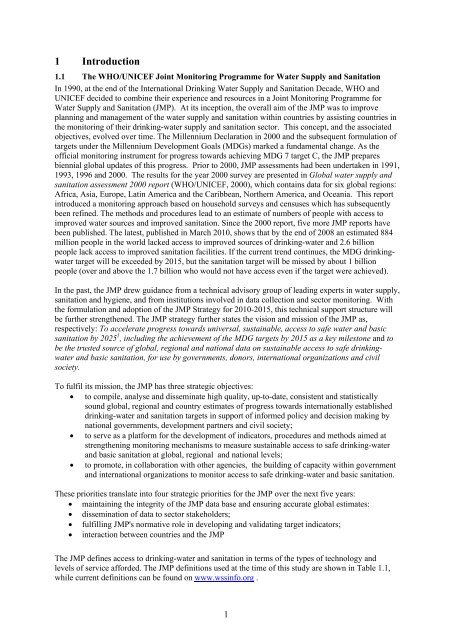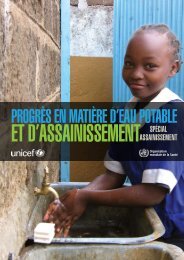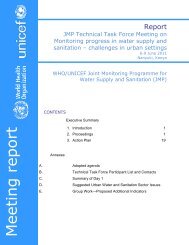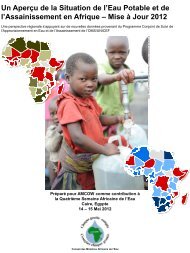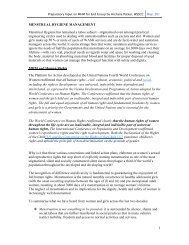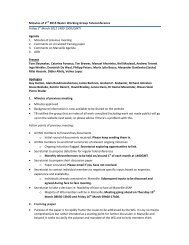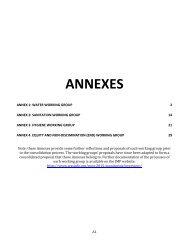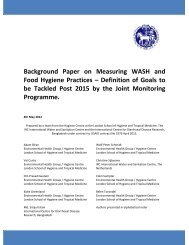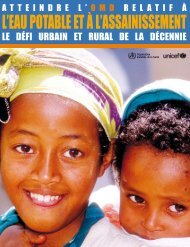rapid assessment of drinking-water quality in the republic of tajikistan
rapid assessment of drinking-water quality in the republic of tajikistan
rapid assessment of drinking-water quality in the republic of tajikistan
You also want an ePaper? Increase the reach of your titles
YUMPU automatically turns print PDFs into web optimized ePapers that Google loves.
1 Introduction<br />
1.1 The WHO/UNICEF Jo<strong>in</strong>t Monitor<strong>in</strong>g Programme for Water Supply and Sanitation<br />
In 1990, at <strong>the</strong> end <strong>of</strong> <strong>the</strong> International Dr<strong>in</strong>k<strong>in</strong>g Water Supply and Sanitation Decade, WHO and<br />
UNICEF decided to comb<strong>in</strong>e <strong>the</strong>ir experience and resources <strong>in</strong> a Jo<strong>in</strong>t Monitor<strong>in</strong>g Programme for<br />
Water Supply and Sanitation (JMP). At its <strong>in</strong>ception, <strong>the</strong> overall aim <strong>of</strong> <strong>the</strong> JMP was to improve<br />
plann<strong>in</strong>g and management <strong>of</strong> <strong>the</strong> <strong>water</strong> supply and sanitation with<strong>in</strong> countries by assist<strong>in</strong>g countries <strong>in</strong><br />
<strong>the</strong> monitor<strong>in</strong>g <strong>of</strong> <strong>the</strong>ir <strong>dr<strong>in</strong>k<strong>in</strong>g</strong>-<strong>water</strong> supply and sanitation sector. This concept, and <strong>the</strong> associated<br />
objectives, evolved over time. The Millennium Declaration <strong>in</strong> 2000 and <strong>the</strong> subsequent formulation <strong>of</strong><br />
targets under <strong>the</strong> Millennium Development Goals (MDGs) marked a fundamental change. As <strong>the</strong><br />
<strong>of</strong>ficial monitor<strong>in</strong>g <strong>in</strong>strument for progress towards achiev<strong>in</strong>g MDG 7 target C, <strong>the</strong> JMP prepares<br />
biennial global updates <strong>of</strong> this progress. Prior to 2000, JMP <strong>assessment</strong>s had been undertaken <strong>in</strong> 1991,<br />
1993, 1996 and 2000. The results for <strong>the</strong> year 2000 survey are presented <strong>in</strong> Global <strong>water</strong> supply and<br />
sanitation <strong>assessment</strong> 2000 report (WHO/UNICEF, 2000), which conta<strong>in</strong>s data for six global regions:<br />
Africa, Asia, Europe, Lat<strong>in</strong> America and <strong>the</strong> Caribbean, Nor<strong>the</strong>rn America, and Oceania. This report<br />
<strong>in</strong>troduced a monitor<strong>in</strong>g approach based on household surveys and censuses which has subsequently<br />
been ref<strong>in</strong>ed. The methods and procedures lead to an estimate <strong>of</strong> numbers <strong>of</strong> people with access to<br />
improved <strong>water</strong> sources and improved sanitation. S<strong>in</strong>ce <strong>the</strong> 2000 report, five more JMP reports have<br />
been published. The latest, published <strong>in</strong> March 2010, shows that by <strong>the</strong> end <strong>of</strong> 2008 an estimated 884<br />
million people <strong>in</strong> <strong>the</strong> world lacked access to improved sources <strong>of</strong> <strong>dr<strong>in</strong>k<strong>in</strong>g</strong>-<strong>water</strong> and 2.6 billion<br />
people lack access to improved sanitation facilities. If <strong>the</strong> current trend cont<strong>in</strong>ues, <strong>the</strong> MDG <strong>dr<strong>in</strong>k<strong>in</strong>g</strong><strong>water</strong><br />
target will be exceeded by 2015, but <strong>the</strong> sanitation target will be missed by about 1 billion<br />
people (over and above <strong>the</strong> 1.7 billion who would not have access even if <strong>the</strong> target were achieved).<br />
In <strong>the</strong> past, <strong>the</strong> JMP drew guidance from a technical advisory group <strong>of</strong> lead<strong>in</strong>g experts <strong>in</strong> <strong>water</strong> supply,<br />
sanitation and hygiene, and from <strong>in</strong>stitutions <strong>in</strong>volved <strong>in</strong> data collection and sector monitor<strong>in</strong>g. With<br />
<strong>the</strong> formulation and adoption <strong>of</strong> <strong>the</strong> JMP Strategy for 2010-2015, this technical support structure will<br />
be fur<strong>the</strong>r streng<strong>the</strong>ned. The JMP strategy fur<strong>the</strong>r states <strong>the</strong> vision and mission <strong>of</strong> <strong>the</strong> JMP as,<br />
respectively: To accelerate progress towards universal, susta<strong>in</strong>able, access to safe <strong>water</strong> and basic<br />
sanitation by 2025 1 , <strong>in</strong>clud<strong>in</strong>g <strong>the</strong> achievement <strong>of</strong> <strong>the</strong> MDG targets by 2015 as a key milestone and to<br />
be <strong>the</strong> trusted source <strong>of</strong> global, regional and national data on susta<strong>in</strong>able access to safe <strong>dr<strong>in</strong>k<strong>in</strong>g</strong><strong>water</strong><br />
and basic sanitation, for use by governments, donors, <strong>in</strong>ternational organizations and civil<br />
society.<br />
To fulfil its mission, <strong>the</strong> JMP has three strategic objectives:<br />
to compile, analyse and dissem<strong>in</strong>ate high <strong>quality</strong>, up-to-date, consistent and statistically<br />
sound global, regional and country estimates <strong>of</strong> progress towards <strong>in</strong>ternationally established<br />
<strong>dr<strong>in</strong>k<strong>in</strong>g</strong>-<strong>water</strong> and sanitation targets <strong>in</strong> support <strong>of</strong> <strong>in</strong>formed policy and decision mak<strong>in</strong>g by<br />
national governments, development partners and civil society;<br />
to serve as a platform for <strong>the</strong> development <strong>of</strong> <strong>in</strong>dicators, procedures and methods aimed at<br />
streng<strong>the</strong>n<strong>in</strong>g monitor<strong>in</strong>g mechanisms to measure susta<strong>in</strong>able access to safe <strong>dr<strong>in</strong>k<strong>in</strong>g</strong>-<strong>water</strong><br />
and basic sanitation at global, regional and national levels;<br />
to promote, <strong>in</strong> collaboration with o<strong>the</strong>r agencies, <strong>the</strong> build<strong>in</strong>g <strong>of</strong> capacity with<strong>in</strong> government<br />
and <strong>in</strong>ternational organizations to monitor access to safe <strong>dr<strong>in</strong>k<strong>in</strong>g</strong>-<strong>water</strong> and basic sanitation.<br />
These priorities translate <strong>in</strong>to four strategic priorities for <strong>the</strong> JMP over <strong>the</strong> next five years:<br />
ma<strong>in</strong>ta<strong>in</strong><strong>in</strong>g <strong>the</strong> <strong>in</strong>tegrity <strong>of</strong> <strong>the</strong> JMP data base and ensur<strong>in</strong>g accurate global estimates:<br />
dissem<strong>in</strong>ation <strong>of</strong> data to sector stakeholders;<br />
fulfill<strong>in</strong>g JMP's normative role <strong>in</strong> develop<strong>in</strong>g and validat<strong>in</strong>g target <strong>in</strong>dicators;<br />
<strong>in</strong>teraction between countries and <strong>the</strong> JMP<br />
The JMP def<strong>in</strong>es access to <strong>dr<strong>in</strong>k<strong>in</strong>g</strong>-<strong>water</strong> and sanitation <strong>in</strong> terms <strong>of</strong> <strong>the</strong> types <strong>of</strong> technology and<br />
levels <strong>of</strong> service afforded. The JMP def<strong>in</strong>itions used at <strong>the</strong> time <strong>of</strong> this study are shown <strong>in</strong> Table 1.1,<br />
while current def<strong>in</strong>itions can be found on www.wss<strong>in</strong>fo.org .<br />
1


